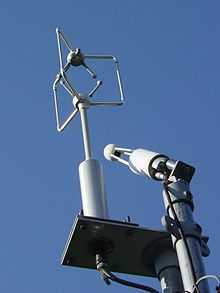LI-COR Biosciences
.png) | |
| Private | |
| Industry | Research / Design / Manufacturing |
| Founded | 1971 |
| Headquarters | Lincoln, NE, U.S.A. |
Key people | William Biggs, Founder |
| Products | Scientific Instruments for Biological and Environmental Research |
| Website | LI-COR website |
LI-COR Biosciences designs, manufactures, and markets instruments for biological and environmental research. It is ISO 9001 certified, meaning that it demonstrates "its ability to consistently provide products (which include services) that enhance customer satisfaction and meet applicable statutory and regulatory requirements."[1]
Origins and history
LI-COR Biosciences is a privately held company based in Lincoln, Nebraska with subsidiaries in Germany and the United Kingdom. It was founded in 1971 under the name Lambda Instruments Corporation. The name was shortened to LI-COR, Inc. in 1978.
Products and Applications
Biotechnology

LI-COR biotechnology instruments and reagents, which are based on near-infrared fluorescent and chemiluminescent detection, are used in a large variety of assays, such as western blot assays and cell-based assays, as well as in vivo imaging and DNA analysis. Primary applications include cancer research,[2] drug discovery,[3] genomics research,[4] neuroscience, cell biology, and education.
Environmental
LI-COR environmental instruments are used for photosynthesis research,[5] greenhouse gas monitoring,[6] greenhouse gas flux measurements,[7] and soil respiration measurements.[8][9] LI-COR also manufactures light sensors, leaf area meters, and plant canopy analyzers,[10] all of which are used to make fundamental measurements in disciplines including plant physiology, climate change, agronomy (forestry and agriculture), and other areas of the natural sciences.
Scientific contributions and recognition
LI-COR automated DNA sequencers were the primary systems used by Genoscope, the French National Sequencing Center to sequence chromosome 14 of the Human Genome Project.
Researchers affiliated with micrometeorological networks around the world use LI-COR carbon dioxide and water vapor analyzers to assess ecosystem greenhouse gas exchange with the eddy covariance technique. These networks include FluxNet and regional networks such as AmeriFlux, ICOS, AsiaFlux, and others.
In 2010, the editors of R&D Magazine selected the LI-7700 Open Path CH4 Analyzer for an R&D 100 Award.[11]
In 2013, the historic benchmark of increase in CO2 concentrations at 400 ppm was reported by the National Oceanic and Atmospheric Administration using LI-7000 Closed Path CO2/H2O gas analyzer.[12]
The LI-6400/6400XT Portable Photosynthesis System is the most frequently cited photosynthesis system in peer-reviewed scientific literature.[13]
Current products
Environmental products
Gas Analyzers:
- LI-7700 Open Path CH4 Analyzer
- LI-7500A Open Path CO2/H2O Analyzer
- LI-7200 Enclosed CO2/H2O Analyzer
- LI-7000 Closed Path CO2/H2O Analyzer
- LI-840A CO2/H2O Analyzer
- LI-820 CO2 Analyzer
Photosynthesis System:
- LI-6400XT Portable Photosynthesis System
Soil CO2 Flux System:
- LI-8100A Automated Soil CO2 Flux System
- LI-8150 Multiplexer
- Soil Flux System Chambers: 8100-102, 8100-103, 8100-104, 8100-104C
Area Meters:
- LAI-2200C Plant Canopy Analyzer
- LI-3000C Portable Area Meter
- LI-3100C Area Meter
Light Sensors:
- Terrestrial Quantum Sensors: LI-190, LI-191
- Underwater Quantum Sensors: LI-192, LI-193
- Pyranometer: LI-200
- Photometric Sensor: LI-210
- Light Meter: LI-250A
Data Loggers:
- LI-1400
- LI-1500
Dew Point Generator:
- LI-610 Portable Dew Point Generator
Biotechnology products
Imaging Systems:
- Odyssey CLx Infrared Imaging System
- Odyssey Sa Infrared Imaging System
- Odyssey Fc Dual-Mode Imaging System
- C-DiGit Chemiluminescent Western Blot Scanner
- Pearl Impulse Imaging System
- 4300 DNA Analysis System
Reagents:
- IRDye Infrared Dye and VRDye Visible Dye secondary antibodues
- WesternSure chemiluminescent reagents
- IRDye infrared dye reagents
- BrightSite optical imaging agents
- CellTag 700 Stain In-Cell Western reagents
- Genomics reagents
References
- ↑ http://www.iso.org/iso/home/standards.htm
- ↑ http://cancerres.aacrjournals.org/content/65/15/6934.full Li, Yiwei, F. Ahmed, S. Ali, P. A. Philip, O. Kucuk, and F. H. Sarkar. (2005). Inactivation of nuclear factor kB by soy isoflavone genistein contributes to increased apoptosis induced by chemotherapeutic agents in human cancer cells. Cancer Research 65: 6934
- ↑ http://journals.lww.com/pancreasjournal/Abstract/2004/05000/Apoptosis_Inducing_Effect_of_Chemotherapeutic.20.aspx Li, Yiwei, K. L. Ellis, S. Ali, B. El-Rayes, A. Nedeljkovic-Kurepa, O. Kucuk, P. A. Philip, and F. H. Sarkar. (2004). Apoptosis-inducing effect of chemotherapeutic agents is potentiated by soy isoflavone genistein, a natural inhibitor of NF-[kappa]B in BxPC-3 pancreatic cancer cell line. Pancreas 28; 90-95.
- ↑ http://www.genetics.org/cgi/content/abstract/165/2/687 Liu, Z., K. Attila, L. Ping, C. Dongfeng, and R. Dunham. (2003). An AFLP-based genetic linkage map of channel catfish (Ictalurus punctatus) construction by using an interspecific hybrid resource family. Genetics 165; 689-694.
- ↑ http://onlinelibrary.wiley.com/doi/10.1111/j.1365-3040.2001.00668.x/full Bernacchi, C. J., E. L. Singsaas, C. Pimental, A. R. Portis Jr., S. P. Long. (2004). Improved temperature response functions for models of Rubisco-limited photosynthesis. Plant, Cell & Environment 24; 253-259.
- ↑ http://www.nature.com/nature/journal/v413/n6856/abs/413622a0.html Luo, Y., S. Wan, D. Hui, and L. L. Wallace. Acclimatization of soil respiration to warming in a tall grass prairie. Nature 413; 622-625.
- ↑ http://dx.doi.org/10.1016/j.agrformet.2006.11.004 Ohkubo, S., Y. Kosugi, S. Takahashi, T. Mitani, and M. Tani. (2006). Comparison of the eddy covariance and automated closed chamber methods for evaluating nocturnal CO2 exchange in Japanese cypress forest. Agricultural and Forest Meteorology 142; 50-65.
- ↑ http://onlinelibrary.wiley.com/doi/10.1111/j.1365-2486.2008.01728.x/full Liu, W., Z. Zhang, S. Wan. (2008). Predominant role of water in regulating soil and microbial respiration and their responses to climate change in a semiarid grassland. Global Change Biology 15; 184-195.
- ↑ http://onlinelibrary.wiley.com/doi/10.1111/j.1469-8137.2008.02481.x/full Vargas, R., M. F. Allen. (2008). Environmental controls and the influence of vegetation type, fine roots and rhizomorphs on diel and seasonal variation in soil respiration. New Phytologist 179; 460-471.
- ↑ http://jxb.oxfordjournals.org/cgi/reprint/47/9/1335.pdf Welles, J. M., S. Cohen. (1996). Canopy structure measurement by gap fraction analysis using commercial instrumentation. Journal of experimental botany 47; 1335-1342.
- ↑ http://www.rdmag.com/Awards/RD-100-Awards/2010/08/Keeping-tabs-on-methane/
- ↑ http://journalstar.com/business/local/li-cor-instruments-established-historic-climate-news/article_0328ea6a-f6da-53d8-bd88-a8d698061b62.html
- ↑ http://www.botany.org/news/newsletters/physiological070122.php